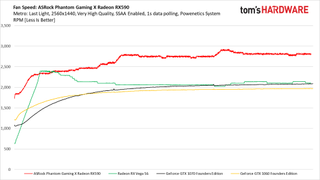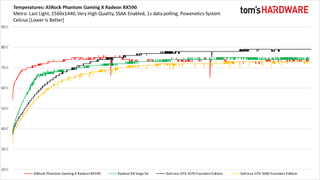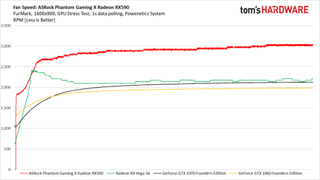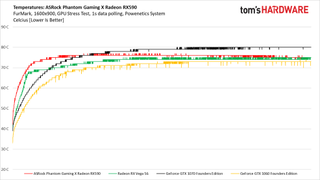ASRock Phantom Gaming X Radeon RX590 8G OC Review
Why you can trust Tom's Hardware
Temperatures, Clock Rates, and Fan Speeds
Gaming

As if the power situation wasn’t bad enough, a look at fan speed tells us a bit about the Phantom Gaming X Radeon RX590’s acoustics. Its ramp is not nice and smooth. Rather, we see three sudden acceleration events during the several minutes it takes to run three loops of the Metro: Last Light benchmark corresponding to each sequence’s conclusion.
At the worst, we record rotational speeds in excess of 2900 RPM. In comparison, the Radeon RX Vega 56’s blower-style cooler crests 2300 RPM before settling down to a more palatable 2100 RPM.

At least the aggressive curve keeps AMD’s Polaris GPU nice and cool. After spiking around 75°C, the Phantom Gaming X settles at 73° as ASRock’s fans shoulder the thermal load. A reference Radeon RX Vega 56 runs hotter, as does Nvidia’s GeForce GTX 1070 Founders Edition, which holds steady at 79°C.


There is no variation in the Radeon RX 590’s clock rate, unlike Nvidia’s cards or the Radeon RX Vega 56. It holds a steady 1560 MHz through the three-loop sequence, dropping briefly between runs.
Voltage isn’t as constant. Similar to what we saw from XFX’s Fatboy in our launch review, it hovers close to 1.175V, allowing ASRock to maintain its relatively high clock rate. Those fast-spinning fans prevent Polaris 30 from hitting a thermal ceiling in this sweet spot of sorts.
FurMark

A rapid temperature increase doesn’t leave the fans with any time to ramp up slowly (or erratically). Instead, the Phantom Gaming X springs from idle to 1800+ RPM, quickly marches its way above 2400 RPM, and continues ramping up beyond 3100 RPM before we shut the workload off.
Most of what you hear at those speeds is the whooshing of fan noise, and it’s most prevalent facing the card head-on. At an angle, or from inside of a case, it isn’t as severe. No matter how you dampen the noise, though, there’s no way to characterize ASRock’s Phantom Gaming X as a quiet card. Rather, it’s one of the loudest we have in the lab.

High fan speeds help keep AMD’s GPU operating at less than 80 degrees. By the end of our FurMark run, it’s roughly the same temperature as the company’s reference Radeon RX Vega 56 and cooler than the GeForce GTX 1070 Founders Edition. The Phantom Gaming X is the quickest to heat up, though.


Our stress test takes a big chunk out of the clock rate ASRock is able to sustain. Voltage drops at the same time, becoming more erratic as the Phantom Gaming X is hamstrung by a power ceiling.
MORE: Best Graphics Cards
MORE: Desktop GPU Performance Hierarchy Table
MORE: All Graphics Content
Current page: Temperatures, Clock Rates, and Fan Speeds
Prev Page Power Consumption Next Page SoftwareStay on the Cutting Edge
Join the experts who read Tom's Hardware for the inside track on enthusiast PC tech news — and have for over 25 years. We'll send breaking news and in-depth reviews of CPUs, GPUs, AI, maker hardware and more straight to your inbox.
